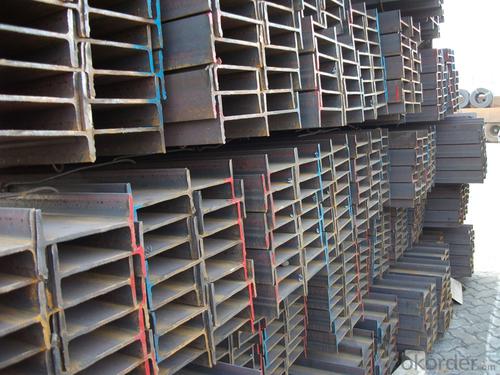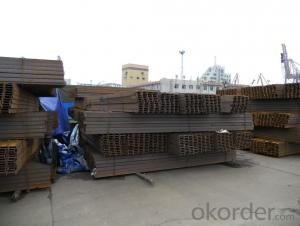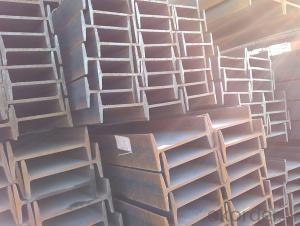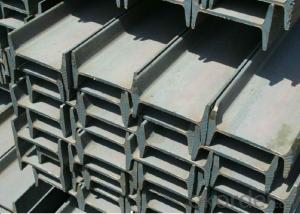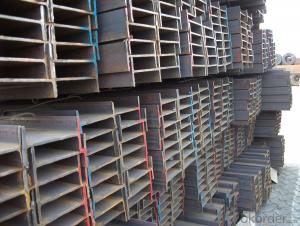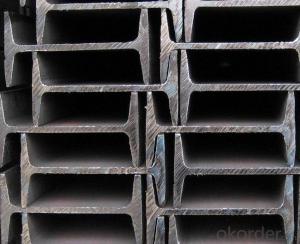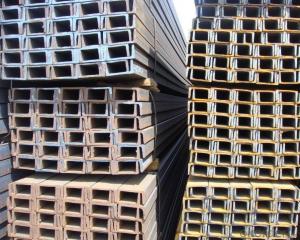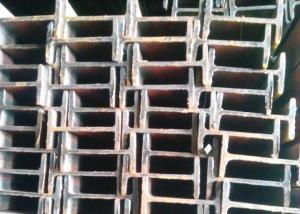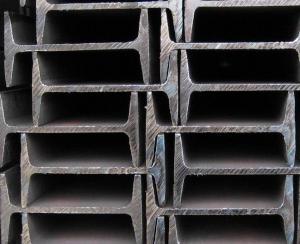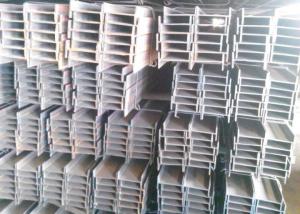Steel I Beams EN Standard IPE / IPEAA in High Quality
- Loading Port:
- Tianjin
- Payment Terms:
- TT or LC
- Min Order Qty:
- 500 m.t.
- Supply Capability:
- 1000 m.t./month
OKorder Service Pledge
OKorder Financial Service
You Might Also Like
OKorder is offering Steel I Beams EN Standard IPE / IPEAA in High Quality at great prices with worldwide shipping. Our supplier is a world-class manufacturer of steel, with our products utilized the world over. OKorder annually supplies products to African, South American and Asian markets. We provide quotations within 24 hours of receiving an inquiry and guarantee competitive prices.
Product Applications:
Steel I Beams EN Standard IPE / IPEAA in High Quality are ideal for structural applications and are widely used in the construction of buildings and bridges, and the manufacturing, petrochemical, and transportation industries.
Product Advantages:
OKorder's Steel I Beams EN Standard IPE / IPEAA in High Quality are durable, strong, and wide variety of sizes.
Main Product Features:
· Premium quality
· Prompt delivery & seaworthy packing (30 days after receiving deposit)
· Can be recycled and reused
· Mill test certification
· Professional Service
· Competitive pricing
Product Specifications:
1. Manufacture: Hot rolled
2. Standard: EN10025, GB Standard, ASTM
3. Grade: Q235B, Q345B, SS400, ASTM A36, S235JR, S275JR
4. Length: 5.8M, 6M, 9M, 12M as following table
5. Sizes: 80mm-270mm
Dimensions(mm) | |||||
h | b | s | t | Mass Kg/m | |
IPE80 | 80 | 46 | 3.80 | 5.20 | 6.00 |
IPE100 | 100 | 55 | 4.10 | 5.70 | 8.10 |
IPE120 | 120 | 64 | 4.80 | 6.30 | 10.40 |
IPE140 | 140 | 73 | 4.70 | 6.90 | 12.90 |
IPE160 | 160 | 82 | 5.00 | 7.40 | 15.80 |
IPE180 | 180 | 91 | 5.30 | 8.00 | 18.80 |
IPE200 | 200 | 100 | 5.60 | 8.50 | 22.40 |
FAQ:
Q1: Why buy Materials & Equipment from OKorder.com?
A1: All products offered byOKorder.com are carefully selected from China's most reliable manufacturing enterprises. Through its ISO certifications, OKorder.com adheres to the highest standards and a commitment to supply chain safety and customer satisfaction.
Q2: How do we guarantee the quality of our products?
A2: We have established an advanced quality management system which conducts strict quality tests at every step, from raw materials to the final product. At the same time, we provide extensive follow-up service assurances as required.
Q3: what is the difference between actual weight and theoretical weight?
A3: All the section steel has two weights: actual weight and theoretical weight. Actual weight is the weighing out when the product delivered from the mill. Theoretical weight is calculated by pieces. The invoice can be based on each of them as your request.
Images:
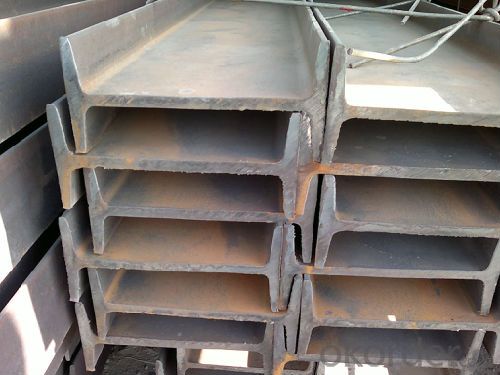
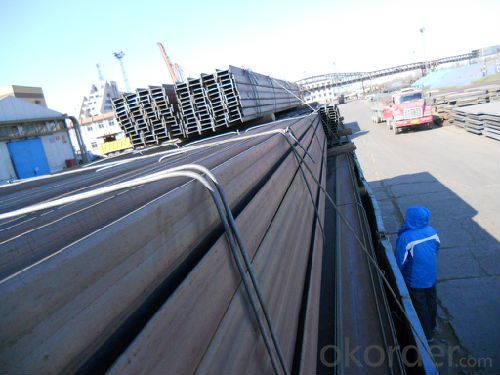
- Q: What are the different grades of steel used in I-beams?
- The specific application and requirements can cause variation in the grades of steel used in I-beams. Some commonly used grades are A36, A572, and A992. A36 steel, commonly utilized in construction and structural applications, is a low carbon steel. It possesses good weldability, machinability, and formability, making it suitable for a wide range of projects. For general structural purposes, A36 steel is often employed in I-beams. A572 steel, a high-strength, low alloy steel, finds common use in structural applications like bridges and buildings. It offers exceptional strength and toughness, making it suitable for heavy-duty construction projects. A572 steel comes in various grades, with A572-50 being the most commonly used due to its minimum yield strength of 50 ksi. A992 steel, a high-strength, low alloy steel, is commonly used in I-beams for structural applications. It possesses a minimum yield strength of 50 ksi and a minimum tensile strength of 65 ksi, making it stronger than A36 and A572 steel. A992 steel is frequently specified for its superior strength and cost-effectiveness in construction projects. Other possible grades of steel used in I-beams include A500, which is a carbon steel structural tubing that is cold-formed and welded/seamless, and A709, which is a carbon and high-strength low alloy steel structural shape, plate, or bar. It is important to note that the selection of the steel grade for I-beams depends on factors such as load-bearing requirements, structural design, and project specifications. Seeking guidance from a structural engineer or steel supplier can aid in determining the most suitable grade of steel for a specific application.
- Q: What does "I-beam 600*200*8*12" mean?
- The height of I-beam is 600mm, the thickness is 8mm, the width is 200, and the thickness is 12mm
- Q: Is H steel welded or rolled? What's the difference between steel and I-beam?
- The difference between H steel and I-beam is the wing width. I-beam is relatively narrow, a wide range of applications; H steel wings relatively wide, generally used for large structures.
- Q: How do you calculate the bearing capacity of a steel I-beam?
- In order to determine the bearing capacity of a steel I-beam, several factors should be taken into account. To begin with, one must be aware of the dimensions and properties of the I-beam, including its height, width, and thickness. These measurements are typically provided by the manufacturer or can be obtained through physical measurements. Afterwards, the material properties of the steel used in the I-beam need to be determined. This includes the yield strength, which indicates the maximum stress the material can withstand without permanent deformation, as well as the modulus of elasticity, which measures the stiffness of the material. Once these measurements and properties are obtained, various formulas and calculations can be utilized to calculate the bearing capacity of the I-beam. One commonly used calculation is Euler's buckling formula, which takes into account the compressive strength of the I-beam. Another crucial aspect to consider is the load applied to the I-beam. This load can consist of both dead loads, such as the weight of the structure it supports, and live loads, such as the weight of people or machinery. The distribution and location of the load also play a significant role in determining the bearing capacity. It is important to emphasize that expertise in structural engineering is necessary to accurately calculate the bearing capacity of a steel I-beam. It is highly recommended to consult with a professional engineer or utilize specialized software to ensure structural safety and accurately determine the bearing capacity.
- Q: Are steel I-beams resistant to pests and insects?
- Steel I-beams are not susceptible to pests and insects. Unlike wood, which can be easily damaged by termites, ants, and other pests, steel is an inorganic material that does not provide a food source for these creatures. This makes steel I-beams highly resistant to infestation and damage caused by pests and insects. Steel structures are often used in construction to mitigate the risk of pest-related issues that can compromise the structural integrity of a building.
- Q: Can steel I-beams be used for column support?
- Yes, steel I-beams can be used for column support.
- Q: Do steel I-beams require any special insulation or soundproofing measures?
- No, steel I-beams do not require any special insulation or soundproofing measures as they are already inherently strong and resistant to sound transmission.
- Q: What are the advantages of using steel I-beams?
- There are numerous benefits to utilizing steel I-beams in construction endeavors. To begin with, steel I-beams are renowned for their exceptional strength and durability. They possess a remarkable load-carrying capacity, enabling them to bear heavy loads and endure extreme weather conditions. This renders them suitable for a diverse array of applications, encompassing bridges, buildings, and industrial structures. Moreover, steel I-beams afford design flexibility. They are available in various sizes and shapes, granting engineers and architects the ability to tailor them to the specific requirements of the project. This adaptability simplifies the creation of intricate structures and maximizes the utilization of space. Furthermore, steel I-beams exhibit fire resistance. Owing to their high melting point, they can withstand elevated temperatures more effectively than alternative materials such as wood or concrete. This attribute proves invaluable in terms of safety, as it affords additional time for evacuation and containment in the event of a fire. Additionally, steel I-beams necessitate minimal maintenance. Unlike wood, which is susceptible to rot or pests, steel is impervious to such issues. This translates into long-term cost savings, as regular repairs or replacements become unnecessary. Another advantage of steel I-beams lies in their eco-friendliness. Steel is an extremely recyclable substance, and the utilization of recycled steel in construction projects aids in diminishing the demand for new raw materials and reducing carbon emissions. Additionally, steel I-beams can be easily dismantled and repurposed in other projects, further contributing to sustainability efforts. Finally, steel I-beams confer excellent structural integrity. They possess consistent dimensions and properties, guaranteeing uniformity and dependability throughout the construction process. This renders them the preferred choice for engineers and builders who prioritize safety and stability. In conclusion, the utilization of steel I-beams in construction projects provides numerous advantages, including strength, design flexibility, fire resistance, low maintenance requirements, eco-friendliness, and structural integrity. These qualities establish steel I-beams as a reliable and efficient option for a wide range of construction endeavors.
- Q: What are the design considerations for steel I-beams?
- To ensure structural integrity and optimal performance when designing steel I-beams, several important considerations must be taken into account: 1. Load-bearing capacity: The ability of steel I-beams to withstand the load they will support is a primary design consideration. Calculating the maximum expected loads and designing the beam with sufficient strength and stiffness to support these loads without excessive deflection or failure is crucial. 2. Span length: Another key consideration is the distance between supports, known as the span length. Longer spans require larger and stronger beams to prevent sagging or excessive deflection. Careful selection of the beam's size, shape, and the spacing and stiffness of the supports is necessary to accommodate the desired span length. 3. Material selection: Choosing the right steel material is critical in beam design. Different grades and types of steel have varying properties that affect load-bearing capacity and structural performance. The appropriate steel grade must be selected to meet specific design requirements. 4. Shape and dimensions: The shape and dimensions of the I-beam significantly impact its performance. The beam's cross-sectional shape, resembling the letter "I," provides an optimal strength-to-weight ratio. Determining the dimensions (width, depth, and thickness of the flanges and web) carefully is necessary to ensure sufficient strength and stiffness while minimizing material usage. 5. Connection details: Proper connection design and detailing between steel I-beams and other structural elements are essential for maintaining overall structural integrity. Effective and secure load transfer to supports or other structural members, while accommodating potential movements and deformations, must be ensured. 6. Fire resistance: Steel can weaken when exposed to high temperatures, making fire resistance a crucial consideration. Various methods, such as fireproof coatings, fire-rated insulation, or encasing beams in fire-resistant materials, can enhance fire resistance. 7. Cost and constructability: Considering cost and constructability is important in designing steel I-beams. Minimizing material usage and fabrication costs while ensuring ease of construction and installation is a goal. Optimizing beam sizes and shapes to achieve the desired performance at an economical cost is often done. In conclusion, designing steel I-beams involves balancing load-bearing capacity, span length, material selection, shape, connection details, fire resistance, cost, and constructability. By carefully considering these factors, engineers can create steel I-beams that meet structural requirements while ensuring safety, efficiency, and durability.
- Q: Are there any maintenance requirements for steel I-beams?
- Yes, there are maintenance requirements for steel I-beams. While steel is a durable material, it is still susceptible to certain factors that can affect its integrity over time. Regular maintenance is necessary to ensure the longevity and safety of steel I-beams. One important maintenance requirement for steel I-beams is inspection. Regular visual inspections should be conducted to identify any signs of damage or deterioration. This includes checking for cracks, corrosion, or any other structural issues that may compromise the strength of the I-beams. Inspections can help identify potential problems early on and allow for timely repairs or replacements. Another maintenance requirement is cleaning. Steel I-beams should be cleaned periodically to remove dirt, debris, or any corrosive substances that may have accumulated on the surface. Cleaning can be done using a mild detergent and water, or specialized cleaning solutions depending on the level of dirt or corrosion present. Regular cleaning helps prevent the buildup of contaminants that can accelerate corrosion or weaken the steel. Additionally, it is important to address any identified issues promptly. If any cracks, corrosion, or damage are found during inspections, it is crucial to take immediate action to repair or replace the affected I-beams. Ignoring or delaying repairs can lead to further deterioration and compromise the structural integrity of the steel beams. Furthermore, in some cases, steel I-beams may require protective coatings or paints to prevent corrosion. These coatings act as a barrier between the steel and its environment, preventing moisture or other corrosive elements from reaching the surface. The type and frequency of coating application may vary depending on the specific conditions and requirements of the application. In conclusion, regular inspection, cleaning, and prompt repairs or replacements are essential maintenance requirements for steel I-beams. By following these maintenance practices, the longevity and performance of steel I-beams can be ensured, ultimately contributing to the safety and durability of structures they support.
Send your message to us
Steel I Beams EN Standard IPE / IPEAA in High Quality
- Loading Port:
- Tianjin
- Payment Terms:
- TT or LC
- Min Order Qty:
- 500 m.t.
- Supply Capability:
- 1000 m.t./month
OKorder Service Pledge
OKorder Financial Service
Similar products
Hot products
Hot Searches
Related keywords




